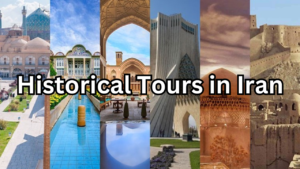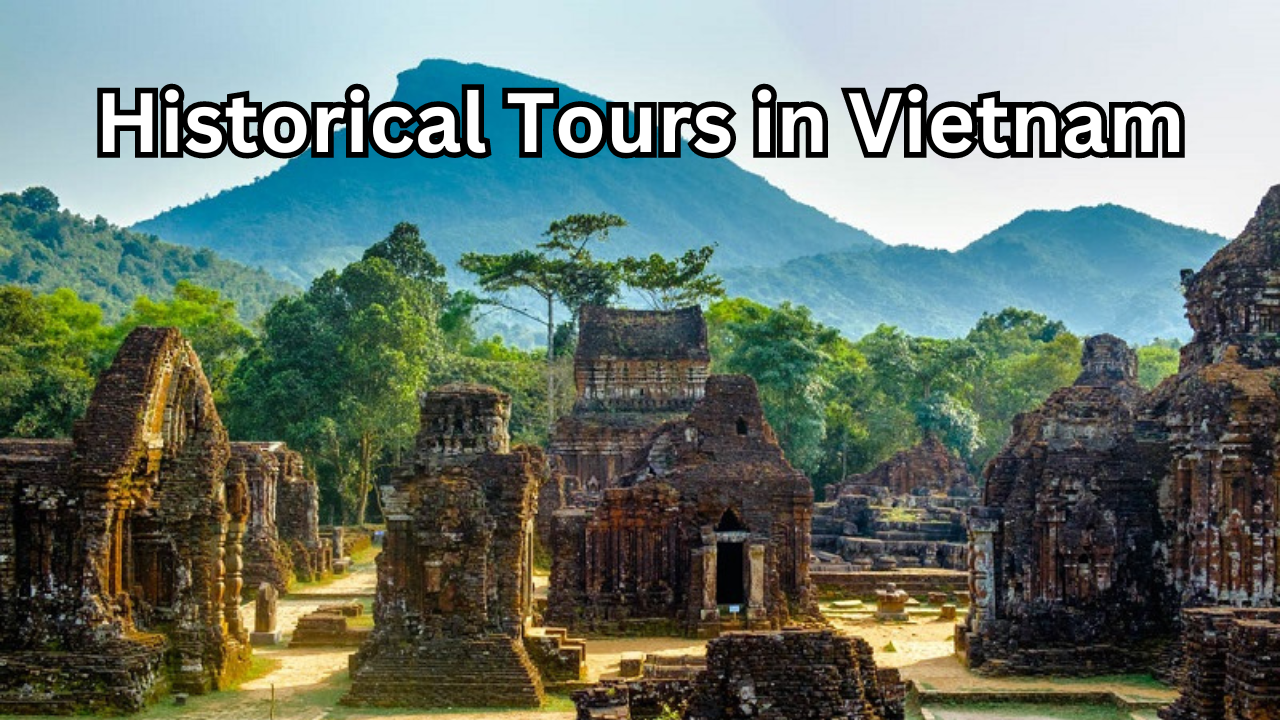
Table of Contents
Introduction:
Vietnam’s historical legacy is as intricate as it is captivating, woven with tales of ancient civilizations, colonial rule, and modern conflicts. Exploring Vietnam through historical tours offers a profound insight into its rich heritage, allowing visitors to unravel the layers of the country’s past. From the bustling streets of Hanoi to the serene landscapes of Hue and the ancient town of Hoi An, each destination tells a unique story that contributes to Vietnam’s cultural tapestry. Let’s embark on a journey through some of the most compelling historical tours in Vietnam, delving into the remnants of empires, the scars of war, and the enduring spirit of a nation shaped by its history.
Brief Overview of Vietnam’s Rich Historical Heritage:
Vietnam’s historical heritage spans thousands of years, encompassing a diverse tapestry of cultures, traditions, and events. The country’s history is marked by ancient civilizations such as the Dong Son culture, which left behind bronze drums and artifacts dating back to 700 BCE. Throughout the centuries, Vietnam witnessed the rise and fall of dynasties like the Ly, Tran, and Nguyen, each leaving their imprint on the land through majestic citadels, temples, and tombs.
During the colonial era, Vietnam came under the influence of foreign powers, including the Chinese, French, and Japanese. This period of colonization profoundly shaped Vietnam’s culture, architecture, and societal norms. The struggle for independence led to significant historical milestones, such as the proclamation of the Democratic Republic of Vietnam by Ho Chi Minh in 1945 and the subsequent wars for liberation and reunification.
The Vietnam War, also known as the American War in Vietnam, remains a pivotal chapter in the nation’s history. The scars of conflict are visible in sites like the Cu Chi Tunnels, where the Viet Cong mounted resistance against opposing forces, showcasing the resilience and determination of the Vietnamese people.
Importance of Historical Tours in Understanding Vietnam’s Past:
Historical tours play a crucial role in unraveling Vietnam’s complex past and fostering a deeper understanding of its heritage. By exploring historical sites, museums, and monuments, visitors gain insights into the cultural, political, and social dynamics that have shaped Vietnam into what it is today.
These tours provide a tangible connection to Vietnam’s history, allowing travelers to witness ancient relics, architectural marvels, and artifacts firsthand. For instance, visiting the Hue Imperial City offers a glimpse into the grandeur of past dynasties, while the Hoi An Ancient Town showcases the fusion of indigenous and foreign influences in Vietnam’s architecture and trade.
Moreover, historical tours shed light on pivotal events like the Vietnam War, offering perspectives from both Vietnamese and international narratives. Sites such as the War Remnants Museum in Ho Chi Minh City and the DMZ area near Hue serve as poignant reminders of the human cost of war and the resilience of the Vietnamese people.
By engaging with Vietnam’s historical heritage through guided tours, visitors not only gain knowledge but also develop empathy and appreciation for the country’s enduring spirit. These experiences contribute to meaningful cross-cultural exchanges and promote a deeper appreciation for Vietnam’s past, present, and future.
Hanoi Historical Tour
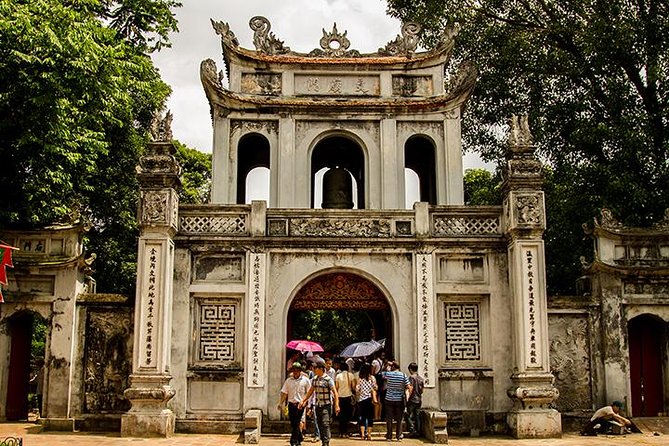
A journey through Hanoi’s historical sites is a captivating exploration of Vietnam’s capital city, steeped in centuries of culture, politics, and tradition. This tour unveils a mosaic of historical landmarks, each offering a window into Hanoi’s rich past and vibrant present.
- Ho Chi Minh Mausoleum:
- Pay homage to Vietnam’s revered leader, Ho Chi Minh, at his final resting place. The imposing mausoleum stands as a symbol of national unity and reverence, where visitors can witness the preserved body of “Uncle Ho.”
- Hoa Lo Prison (Hanoi Hilton):
- Delve into the somber history of Hoa Lo Prison, known ironically as the “Hanoi Hilton” during the Vietnam War. Explore the prison’s grim past, including its use during French colonial rule and as a detention center for American prisoners of war.
- Temple of Literature:
- Step back in time at the Temple of Literature, Vietnam’s first national university and a tribute to Confucian scholars. Admire the well-preserved architecture, serene courtyards, and ancient stelae honoring scholars of past dynasties.
- Old Quarter with Colonial Architecture:
- Wander through the bustling streets of Hanoi’s Old Quarter, a maze of narrow lanes filled with bustling markets, traditional shops, and colonial-era buildings. Experience the juxtaposition of ancient Vietnamese culture and French colonial influences.
- One Pillar Pagoda:
- Visit the iconic One Pillar Pagoda, a symbol of Hanoi’s spiritual heritage. This unique pagoda, built on a single stone pillar in a lotus pond, reflects Vietnam’s Buddhist traditions and architectural ingenuity.
- Hoan Kiem Lake and Ngoc Son Temple:
- Take a leisurely stroll around Hoan Kiem Lake, a picturesque oasis in the heart of Hanoi. Admire the scenic beauty and visit Ngoc Son Temple, dedicated to the national hero Tran Hung Dao and home to the famous “Turtle Tower.”
- French Quarter:
- Explore Hanoi’s French Quarter, characterized by wide boulevards, elegant colonial buildings, and historic landmarks like the Opera House and the Presidential Palace. Immerse yourself in the charm of French colonial architecture amidst a bustling Asian metropolis.
- Vietnam Museum of Ethnology:
- Gain insights into Vietnam’s diverse ethnic groups and cultural heritage at the Vietnam Museum of Ethnology. Discover traditional artifacts, exhibits on minority communities, and interactive displays showcasing Vietnam’s cultural mosaic.
A Hanoi Historical Tour is a captivating journey through time, offering a nuanced understanding of Vietnam’s capital city and its enduring historical significance. From ancient temples to colonial legacies, Hanoi’s treasures await those eager to delve into the layers of its past.
Hue Imperial City Tour
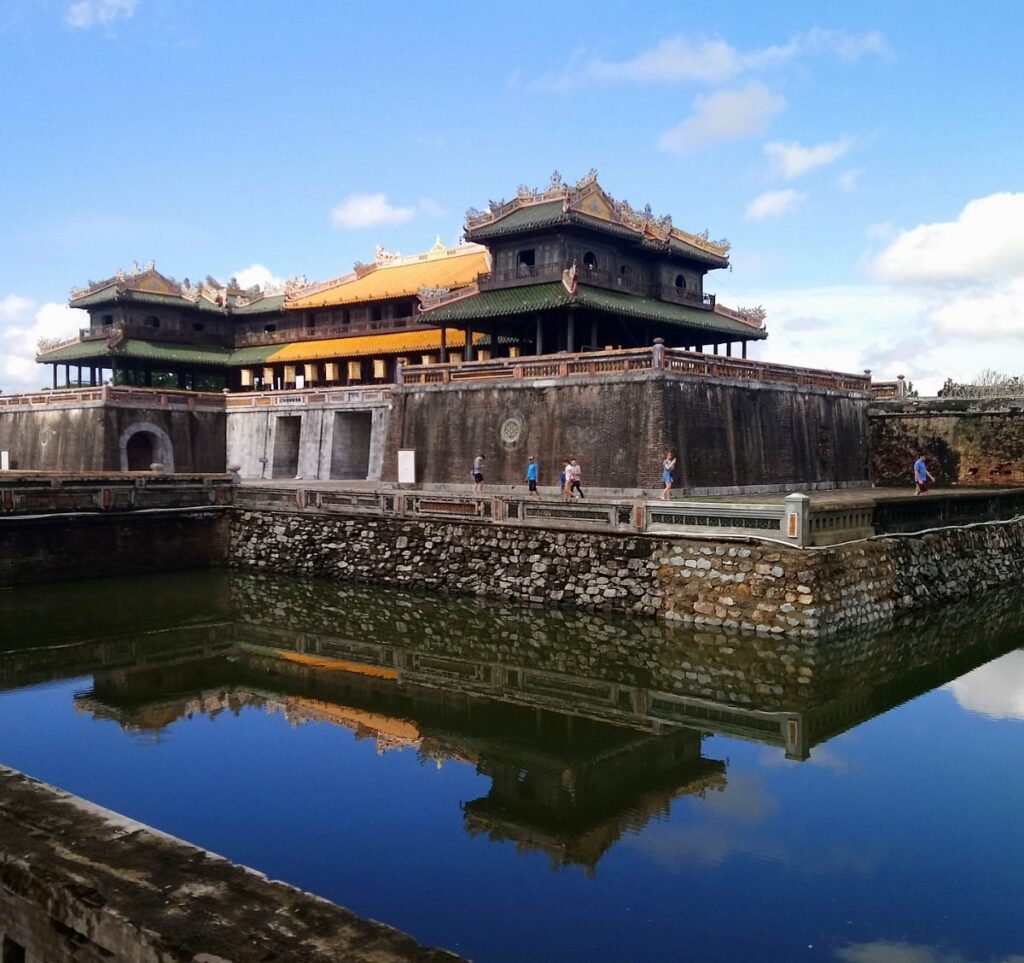
Embark on a captivating journey through Vietnam’s imperial past with a tour of Hue’s majestic Imperial City. Nestled along the Perfume River, Hue served as the capital of the Nguyen Dynasty and remains a treasure trove of historical and cultural landmarks.
- Imperial City:
- Step into the heart of Vietnam’s royal heritage as you enter the Imperial City, a UNESCO World Heritage site. Explore the fortified citadel, with its impressive gates, palaces, and gardens, reflecting the grandeur of past dynasties.
- Royal Tombs along the Perfume River:
- Cruise along the Perfume River to visit the ornate royal tombs of emperors such as Minh Mang, Khai Dinh, and Tu Duc. Marvel at the intricate architecture, beautiful gardens, and tranquil surroundings of these final resting places.
- Thien Mu Pagoda:
- Discover the iconic Thien Mu Pagoda, a symbol of Hue’s spiritual heritage. Admire the seven-tiered pagoda overlooking the river, housing ancient relics and offering panoramic views of the surrounding landscapes.
- Traditional Garden Houses:
- Explore Hue’s traditional garden houses, known for their unique architecture and harmonious blend of nature and human craftsmanship. Gain insights into Vietnamese ancestral homes and their cultural significance.
- Dong Ba Market:
- Immerse yourself in Hue’s vibrant local culture at Dong Ba Market, a bustling hub of food, handicrafts, and everyday life. Sample local delicacies, shop for souvenirs, and experience the lively atmosphere of this historic market.
- Imperial Citadel Gate:
- Stand in awe of the majestic Ngo Mon Gate, the main entrance to the Imperial Citadel. Admire the intricate design, including the Five Phoenix Pavilion and the towering flag tower, symbolizing the imperial authority of bygone eras.
- Hue Museum of Royal Antiquities:
- Delve deeper into Hue’s royal history at the Hue Museum of Royal Antiquities, housing a vast collection of artifacts, royal garments, and cultural relics from the Nguyen Dynasty. Gain insights into court life and the legacy of Vietnam’s emperors.
- Hue’s Cultural Performances:
- Experience Hue’s vibrant cultural heritage through traditional music and dance performances, showcasing the region’s rich artistic traditions and storytelling.
A Hue Imperial City Tour is a captivating odyssey through Vietnam’s royal legacy, offering a glimpse into the opulence, spirituality, and artistic achievements of past dynasties. Discover the timeless allure of Hue’s imperial treasures as you unravel the secrets of this historic capital.
Hoi An Ancient Town Tour
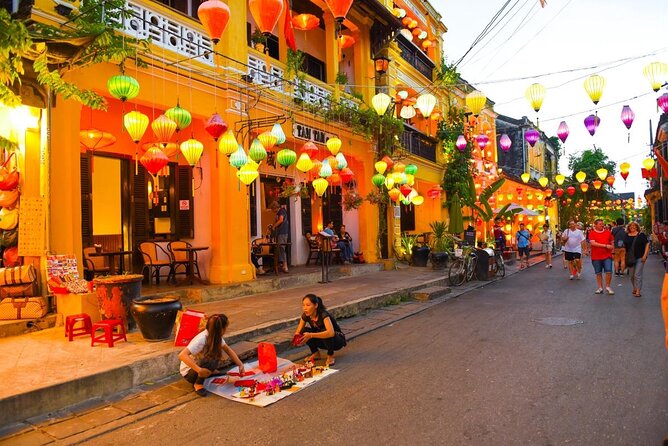
Step into a living museum of Vietnam’s cultural heritage with a tour of Hoi An Ancient Town, a UNESCO World Heritage site renowned for its well-preserved architecture, vibrant markets, and rich history.
- Japanese Covered Bridge:
- Begin your journey at the iconic Japanese Covered Bridge, a symbol of Hoi An’s multicultural past. Marvel at the intricate design of this 18th-century bridge, blending Japanese and Vietnamese architectural styles.
- Assembly Halls:
- Explore Hoi An’s historic assembly halls, built by Chinese communities to honor their ancestors and conduct communal activities. Visit the Assembly Hall of the Fujian Chinese Congregation and the Cantonese Assembly Hall, adorned with ornate decorations and altars.
- Ancient Houses:
- Wander through the narrow alleyways lined with ancient houses, each telling a story of Hoi An’s trading history and cultural exchange. Admire the traditional wooden architecture, intricate carvings, and tranquil courtyards of these well-preserved homes.
- Tan Ky Old House:
- Visit Tan Ky Old House, a cultural gem showcasing the blend of Vietnamese, Chinese, and Japanese influences. Explore its unique architectural features, including carved wooden beams, ancestral altars, and a central courtyard.
- Hoi An Central Market:
- Immerse yourself in the bustling atmosphere of Hoi An Central Market, where local vendors sell fresh produce, handicrafts, and traditional goods. Experience the sights, sounds, and flavors of daily life in this vibrant market.
- Folklore Museum:
- Dive into Hoi An’s folklore and traditions at the Folklore Museum, featuring exhibits on local customs, festivals, and legends. Learn about Hoi An’s cultural heritage through artifacts, costumes, and interactive displays.
- Thu Bon River Boat Ride:
- Embark on a leisurely boat ride along the Thu Bon River, offering panoramic views of Hoi An’s riverside scenery and ancient waterfront houses. Discover hidden gems along the riverbanks and capture the town’s timeless charm from a different perspective.
- Lantern-Lit Streets:
- As dusk falls, experience the enchanting beauty of Hoi An’s lantern-lit streets. Witness the town come alive with a warm glow as traditional lanterns illuminate the historic buildings, creating a magical ambiance.
- Cultural Workshops:
- Engage in hands-on cultural workshops, such as lantern making, traditional cooking classes, or silk weaving demonstrations. Learn about Hoi An’s artisanal crafts and take home a piece of its cultural legacy.
A Hoi An Ancient Town Tour is a captivating journey through centuries of history, art, and tradition, offering a glimpse into Vietnam’s cultural tapestry and the enduring charm of this enchanting town. Explore the past while savoring the present in Hoi An’s timeless streets and storied landmarks.
UNESCO-listed Old Town:
Hoi An’s UNESCO-listed old town is a testament to its historical significance and architectural charm. The town’s designation as a World Heritage site recognizes its well-preserved heritage, cultural diversity, and contributions to Vietnam’s history. Strolling through the narrow streets of the old town, visitors are transported back in time to a bygone era of bustling trading ports and cultural exchange.
Well-preserved Architecture:
The architecture of Hoi An’s ancient buildings is a captivating blend of Vietnamese, Chinese, Japanese, and European influences. The town’s centuries-old houses, temples, and communal halls showcase intricate carvings, colorful facades, and traditional building techniques that have stood the test of time. From ornate merchant houses to elegant pagodas, each structure tells a story of Hoi An’s cosmopolitan past and architectural ingenuity.
Ancient Houses and Assembly Halls:
Hoi An’s ancient houses and assembly halls are among its most fascinating landmarks, reflecting the town’s multicultural heritage. These well-preserved structures serve as living museums, offering insights into the daily lives, beliefs, and traditions of Hoi An’s diverse communities. Explore the interior courtyards, ancestral altars, and ornamental details of houses like Tan Ky and Quan Thang, or visit the Fujian and Cantonese Assembly Halls adorned with elaborate decorations and cultural artifacts.
Japanese Covered Bridge:
The Japanese Covered Bridge is an iconic symbol of Hoi An and a testament to its historical connections with Japan. Dating back to the 18th century, this picturesque bridge spans a small waterway and features a unique roofed structure with intricate carvings and a small temple inside. The bridge’s architectural significance and cultural heritage make it a must-visit landmark, offering panoramic views of Hoi An’s ancient town and the Thu Bon River.
Together, these elements create a captivating tapestry of history, culture, and architecture in Hoi An’s ancient town, inviting visitors to immerse themselves in its timeless allure and UNESCO-listed heritage.
Cu Chi Tunnels Tour
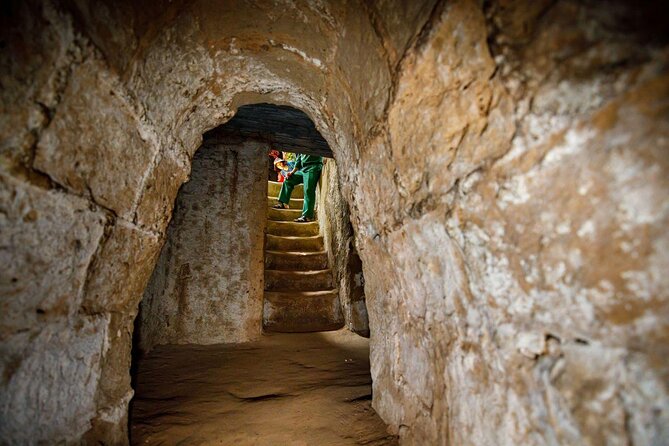
The Cu Chi Tunnels Tour offers a captivating glimpse into Vietnam’s wartime history and the ingenuity of the Viet Cong during the Vietnam War. Situated in the Cu Chi district near Ho Chi Minh City, these underground tunnels served as a vital lifeline and strategic stronghold for the Vietnamese resistance against opposing forces.
- Historical Context:
- Begin your tour with a historical overview of the Cu Chi Tunnels and their significance during the Vietnam War. Learn about the resilience and resourcefulness of the Viet Cong guerrillas who constructed and utilized these tunnels as a key part of their resistance strategy.
- Exploration of the Tunnels:
- Descend into the intricate network of tunnels, which spanned over 250 kilometers in length and included living quarters, command centers, weapon caches, and even hospitals. Experience firsthand the cramped conditions and clever design features that allowed the Viet Cong to evade detection and launch surprise attacks.
- Booby Traps and Defensive Measures:
- Discover the various booby traps and defensive measures employed by the Viet Cong to protect the tunnels from enemy incursions. View examples of camouflaged trapdoors, spike pits, and hidden entrances designed to thwart enemy forces and preserve the tunnel network.
- Weapon Demonstrations:
- Witness demonstrations of the weapons and traps used by the Viet Cong, including the infamous punji stake traps, bamboo spike traps, and improvised explosives. Gain insights into the guerrilla tactics and asymmetrical warfare tactics employed by the Vietnamese forces.
- Tunnel Museum and Exhibits:
- Visit the Cu Chi Tunnels Museum to explore exhibits showcasing artifacts, photographs, and documents related to the Vietnam War and the Cu Chi tunnel system. Gain a deeper understanding of the human cost of war and the perseverance of those who fought for independence.
- Optional Activities:
- Depending on the tour package, you may have the opportunity to participate in additional activities such as firing AK-47 rifles at a shooting range, experiencing a meal of traditional wartime rations, or watching documentaries about the Cu Chi Tunnels’ history.
- Reflection and Remembrance:
- Conclude your tour with a moment of reflection at the tunnels, contemplating the resilience and sacrifices of those who lived and fought in this underground world. Pay homage to the enduring spirit of the Vietnamese people and their quest for freedom and independence.
The Cu Chi Tunnels Tour offers a poignant and educational experience, highlighting both the hardships of war and the indomitable human spirit in the face of adversity. It serves as a reminder of Vietnam’s tumultuous past and its journey towards reconciliation and peace.
Cu Chi District near Ho Chi Minh City:
Located in the Cu Chi district near Ho Chi Minh City, the Cu Chi Tunnels are a testament to the resilience and ingenuity of the Vietnamese people during the Vietnam War. This area, once a stronghold of the Viet Cong guerrillas, offers a poignant glimpse into the wartime history of Vietnam.
Underground Tunnels Used by the Viet Cong:
The Cu Chi Tunnels were a vital part of the Viet Cong’s military strategy, serving as an extensive network of underground passages, chambers, and bunkers. These tunnels, stretching over 250 kilometers, provided shelter, communication routes, supply lines, and hiding spots for the Viet Cong fighters. Designed with meticulous detail, the tunnels included living quarters, storage areas, field hospitals, and command centers, showcasing the resourcefulness and adaptability of the guerrilla forces.
Vietnam War History and Significance:
The Cu Chi Tunnels hold immense historical significance, representing the guerrilla warfare tactics employed by the Viet Cong during the Vietnam War. The tunnels played a crucial role in the resistance against American and South Vietnamese forces, allowing the Viet Cong to evade detection, launch surprise attacks, and sustain their operations in the face of superior firepower.
Exploring the Cu Chi Tunnels offers insights into the harsh realities of war, the perseverance of the Vietnamese people, and the human cost of conflict. Visitors can learn about the strategic importance of the tunnels, the daily life of Viet Cong fighters underground, and the innovative methods used to combat enemy forces. The tour also provides opportunities to view artifacts, weapons, and exhibits related to the Vietnam War, fostering a deeper understanding of this turbulent period in history and the enduring legacy of those who fought for freedom and independence.
Ho Chi Minh City Historical Tour
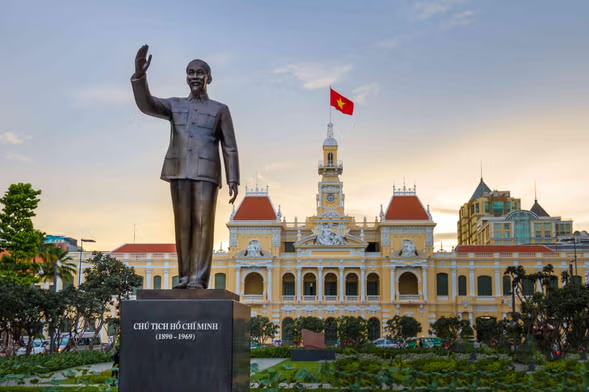
Embark on a captivating journey through the vibrant streets of Ho Chi Minh City, formerly known as Saigon, to discover its rich historical heritage shaped by centuries of cultural exchange, colonial rule, and wartime struggles.
- War Remnants Museum:
- Begin your tour with a visit to the War Remnants Museum, offering a poignant portrayal of Vietnam’s wartime history. Explore exhibitions showcasing artifacts, photographs, and narratives related to the Vietnam War, highlighting the human cost and impact of the conflict.
- Reunification Palace:
- Delve into Vietnam’s modern history at the Reunification Palace, a symbol of the country’s reunification after the Vietnam War. Tour the preserved rooms, communication centers, and underground bunkers that once housed South Vietnam’s government officials.
- Notre Dame Cathedral and Central Post Office:
- Explore the colonial legacy of Ho Chi Minh City with a visit to Notre Dame Cathedral and the adjacent Central Post Office. Admire the French Gothic architecture of the cathedral, constructed with red bricks imported from France, and marvel at the grandeur of the historic post office building.
- Ben Thanh Market:
- Immerse yourself in the vibrant atmosphere of Ben Thanh Market, one of the city’s oldest and most bustling markets. Wander through stalls selling local produce, handicrafts, clothing, and souvenirs, and experience the hustle and bustle of daily life in Saigon.
- Saigon Opera House:
- Discover the elegance of the Saigon Opera House, a stunning example of French colonial architecture. Admire its neoclassical façade and attend a performance or cultural event to appreciate the city’s thriving arts scene.
- Cu Chi Tunnels Day Trip:
- Take a day trip from Ho Chi Minh City to explore the historic Cu Chi Tunnels, a vital part of the Viet Cong’s resistance strategy during the Vietnam War. Descend into the underground passages, learn about guerrilla warfare tactics, and gain insights into Vietnam’s wartime history.
- Museum of Ho Chi Minh City:
- Visit the Museum of Ho Chi Minh City to delve into the city’s past, from its origins as a Khmer settlement to its development under French colonial rule and its transformation into a bustling metropolis. Discover artifacts, maps, and exhibits depicting Saigon’s evolution over the centuries.
- Thich Quang Duc Monument:
- Pay homage to Thich Quang Duc, a Buddhist monk who famously self-immolated in protest against the South Vietnamese government’s policies in 1963. The monument commemorates his sacrifice and serves as a reminder of Vietnam’s struggle for freedom and social justice.
A Ho Chi Minh City Historical Tour offers a multifaceted exploration of the city’s complex history, blending cultural landmarks, wartime legacies, and colonial heritage to create a compelling narrative of Vietnam’s past and present.
War Remnants Museum:
Begin your historical tour of Ho Chi Minh City with a visit to the War Remnants Museum. This museum offers a sobering and insightful look into the Vietnam War from a Vietnamese perspective. Explore the various exhibits, including photographs, artifacts, and military equipment, that depict the realities of the war and its impact on the Vietnamese people. Gain a deeper understanding of the conflict’s historical context, the resilience of the Vietnamese population, and the pursuit of peace and reconciliation.
Reunification Palace:
Continue your journey through Vietnam’s history with a visit to the Reunification Palace, also known as Independence Palace. This iconic landmark played a pivotal role in Vietnam’s reunification after the Vietnam War. Explore the palace’s preserved rooms, meeting halls, and underground bunkers, gaining insights into the political, social, and cultural dynamics of post-war Vietnam. Admire the architectural features and historical significance of this symbol of national unity.
Notre Dame Cathedral and Central Post Office:
Immerse yourself in the colonial heritage of Ho Chi Minh City by visiting Notre Dame Cathedral and the Central Post Office. Marvel at the neo-Romanesque architecture of Notre Dame Cathedral, constructed with red bricks imported from France, and admire its twin bell towers. Next, explore the grandeur of the Central Post Office, designed by Gustave Eiffel, featuring a blend of Gothic, Renaissance, and French colonial styles. Send postcards or souvenirs from this historic post office, which continues to serve as a functioning postal hub.
Ben Thanh Market:
Conclude your historical tour with a visit to Ben Thanh Market, a bustling and vibrant marketplace that epitomizes the energy of Ho Chi Minh City. Wander through the maze of stalls offering a wide array of goods, including local produce, handicrafts, clothing, accessories, and souvenirs. Immerse yourself in the sights, sounds, and aromas of this bustling market, bargaining with vendors and sampling delicious Vietnamese street food. Experience the pulse of daily life in Saigon at Ben Thanh Market, a must-visit destination for both locals and tourists alike.
This comprehensive tour of Ho Chi Minh City’s historical landmarks provides a nuanced understanding of Vietnam’s past, from wartime struggles and political transitions to colonial legacies and contemporary urban life. Explore the layers of history and culture that define this dynamic city, leaving with a deeper appreciation for its heritage and resilience.
My Son Sanctuary Tour
Embark on a captivating journey through time with a My Son Sanctuary Tour, exploring the ancient remnants of the Champa civilization nestled amidst lush Vietnamese landscapes.
- Historical Significance:
- Begin your tour with an introduction to the historical significance of My Son Sanctuary. This UNESCO World Heritage site is a testament to the architectural and cultural achievements of the Champa Kingdom, dating back to the 4th century AD. Learn about the religious and spiritual practices of the Cham people, who constructed these magnificent temple complexes dedicated to Hindu deities like Shiva.
- Architectural Marvels:
- Marvel at the architectural marvels of My Son Sanctuary as you explore the cluster of red brick temples and structures. Admire the intricate carvings, decorative motifs, and symbolic elements that adorn these ancient temples, reflecting a fusion of Cham, Indian, and Southeast Asian architectural styles.
- Champa Civilization:
- Dive into the history and culture of the Champa civilization, which thrived in central Vietnam for centuries. Discover the significance of My Son as a religious and cultural center, where ceremonies, rituals, and festivals were held to honor the gods and ancestors of the Cham people.
- Temple Complexes:
- Explore the various temple complexes within My Son Sanctuary, each offering unique insights into Champa art, religion, and society. Visit notable structures such as the Temple of Po Nagar Kalan, the Temple of Tra Kieu, and the Group A, B, C, D clusters, each with its own architectural features and historical significance.
- Cultural Performances:
- Experience vibrant cultural performances showcasing traditional Cham music, dance, and rituals. Witness the graceful movements, colorful costumes, and rhythmic beats that bring the ancient traditions of the Cham people to life, providing a sensory immersion into their cultural heritage.
- Natural Surroundings:
- Appreciate the natural beauty of the surroundings as you wander through the lush greenery and tranquil landscapes surrounding My Son Sanctuary. Take in the serene ambiance and scenic vistas, connecting with the spiritual essence of this sacred site nestled amidst nature.
- Archaeological Insights:
- Gain insights into the archaeological excavations and preservation efforts at My Son Sanctuary, aimed at safeguarding and interpreting the rich heritage of the Champa civilization. Learn about ongoing research, conservation projects, and the significance of My Son as a window into Vietnam’s ancient past.
A My Son Sanctuary Tour offers a captivating blend of history, art, spirituality, and natural beauty, providing a deeper understanding of Vietnam’s cultural heritage and the legacy of the Champa civilization. Immerse yourself in the timeless allure of this archaeological treasure, uncovering the secrets of a bygone era preserved within these ancient temple ruins.
UNESCO World Heritage Site near Hoi An:
Embark on a journey to My Son Sanctuary, a UNESCO World Heritage site located near Hoi An, Vietnam. This sacred complex of ancient temples and ruins holds immense cultural and historical significance, drawing visitors from around the world to marvel at its architectural splendor and spiritual heritage.
Ancient Hindu Temples built by the Champa Civilization:
Explore the mesmerizing ancient Hindu temples built by the Champa civilization between the 4th and 14th centuries AD. Admire the red brick structures adorned with intricate carvings, sculptures of deities, and decorative motifs that reflect the artistic prowess and religious devotion of the Cham people. Discover the unique blend of Cham, Indian, and Southeast Asian architectural styles that characterize these temple complexes, including the iconic Temple of Po Nagar Kalan and the Group A, B, C, D clusters.
Historical and Cultural Significance:
Delve into the historical and cultural significance of My Son Sanctuary as you uncover the mysteries of the Champa civilization. Learn about the religious practices, rituals, and ceremonies that were conducted within these sacred temples, dedicated to Hindu deities like Shiva, Vishnu, and others. Gain insights into the social structure, artistic achievements, and technological advancements of the Cham people, who flourished in central Vietnam for centuries.
My Son Sanctuary serves as a testament to the ingenuity, creativity, and spiritual beliefs of the Champa civilization, offering a glimpse into Vietnam’s ancient past and cultural diversity. The site’s inclusion as a UNESCO World Heritage site underscores its universal value and importance in preserving humanity’s shared heritage. As you explore the temple ruins and immerse yourself in the tranquil surroundings, you’ll feel a deep connection to the history, artistry, and spirituality that define My Son Sanctuary as a timeless treasure of Vietnam’s cultural legacy.
DMZ (Demilitarized Zone) Tour
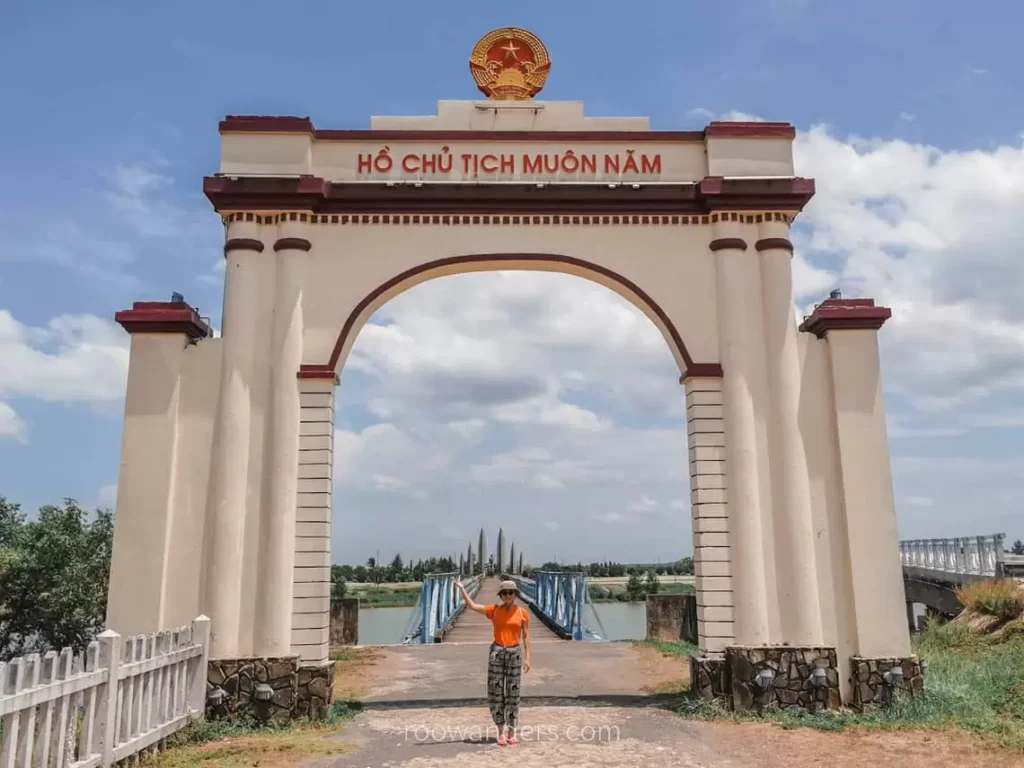
The DMZ (Demilitarized Zone) Tour offers a unique and insightful journey through one of the most historically significant regions of Vietnam, marked by the remnants of the Vietnam War and the enduring spirit of resilience.
- Former DMZ Area near Hue:
- Begin your tour in the former DMZ area near Hue, where the Demilitarized Zone once divided North and South Vietnam during the war. Explore this historically charged region, which witnessed intense military operations, strategic bases, and significant battles.
- Vinh Moc Tunnels:
- Venture into the underground world of the Vinh Moc Tunnels, an intricate network of tunnels dug by villagers as shelter from bombings during the war. Learn about the resilience and ingenuity of the local community as you navigate through the tunnels and hear stories of survival amidst adversity.
- Khe Sanh Combat Base:
- Visit the historic Khe Sanh Combat Base, a key military stronghold during the Vietnam War. Explore the remnants of bunkers, artillery positions, and strategic defenses, gaining insights into the strategic importance of this area and the challenges faced by soldiers on both sides of the conflict.
- Ben Hai River and Vietnam War History:
- Reflect on the historical significance of the Ben Hai River, which served as the demarcation line between North and South Vietnam during the war. Learn about the geopolitical dynamics, ceasefire agreements, and the impact of the division on Vietnamese civilians and soldiers.
- Historical Sites and Memorials:
- Visit poignant historical sites and memorials along the DMZ, including the Truong Son National Cemetery, dedicated to soldiers who fought and perished during the war. Pay tribute to the sacrifices made by individuals and communities, and gain a deeper understanding of the human cost of conflict.
- Local Communities and Cultural Insights:
- Interact with local communities living in the DMZ area, hearing firsthand accounts of wartime experiences, resilience, and reconciliation efforts. Gain insights into the cultural heritage, traditions, and aspirations of the Vietnamese people living in this historically significant region.
- Museum Exhibits and Interpretive Centers:
- Explore museum exhibits and interpretive centers dedicated to preserving the history and memory of the Vietnam War and the DMZ area. View artifacts, photographs, and documents that shed light on the war’s impact, legacies, and ongoing efforts for peace and reconciliation.
The DMZ Tour offers a profound and educational experience, allowing visitors to connect with Vietnam’s complex history, honor the sacrifices of those who lived through the war, and gain perspectives on the enduring quest for peace and understanding in the aftermath of conflict.
Former DMZ Area near Hue:
Embark on a journey through the former DMZ area near Hue, a region steeped in the history of the Vietnam War. This area served as the dividing line between North and South Vietnam, witnessing intense military activities, strategic bases, and significant battles. Explore the remnants of wartime infrastructure, bunkers, and historical sites that bear witness to the turbulent past of this once heavily fortified zone.
Vinh Moc Tunnels:
Descend into the underground world of the Vinh Moc Tunnels, a remarkable network of tunnels dug by villagers to shelter from bombings during the war. Marvel at the ingenuity and resilience of the local community as you navigate through the narrow passages and rooms carved out of the earth. Learn about the hardships faced by civilians living in the war zone and gain insights into their daily lives underground.
Khe Sanh Combat Base:
Step into the historical footsteps of soldiers at the Khe Sanh Combat Base, a pivotal military stronghold during the Vietnam War. Explore the remains of bunkers, artillery positions, and defensive structures that played a crucial role in the conflict. Gain a deeper understanding of the strategic significance of Khe Sanh and the challenges faced by American and South Vietnamese forces during the siege of the base.
Ben Hai River and Vietnam War History:
Contemplate the significance of the Ben Hai River, which served as the demarcation line between North and South Vietnam during the war. Reflect on the geopolitical dynamics, ceasefire agreements, and the human impact of the division on Vietnamese civilians and soldiers. Gain insights into the history of the Vietnam War, its legacies, and ongoing efforts for reconciliation and peace.
As you journey through the former DMZ area, exploring Vinh Moc Tunnels, Khe Sanh Combat Base, and reflecting on the Ben Hai River, you’ll gain a deeper appreciation for Vietnam’s complex history, the resilience of its people, and the quest for healing and understanding in the aftermath of conflict. The DMZ Tour offers a poignant and educational experience, highlighting the enduring impact of war and the human stories that define Vietnam’s past and present.
Phong Nha-Ke Bang National Park Tour
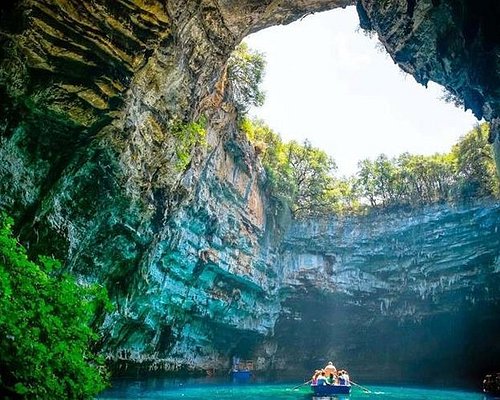
Embark on a breathtaking adventure with a Phong Nha-Ke Bang National Park Tour, immersing yourself in the natural wonders, ancient caves, and rich biodiversity of one of Vietnam’s most captivating UNESCO World Heritage sites.
- Introduction to Phong Nha-Ke Bang National Park:
- Begin your tour with an introduction to Phong Nha-Ke Bang National Park, a pristine natural paradise located in the Quang Binh Province of central Vietnam. Learn about its UNESCO World Heritage status, recognized for its exceptional geological formations, diverse ecosystems, and cultural heritage.
- Phong Nha Cave:
- Explore the majestic Phong Nha Cave, one of the largest and most spectacular caves in the world. Cruise along the Son River and marvel at the mesmerizing stalactites, stalagmites, and underground rivers that adorn the cave’s vast chambers. Admire the natural beauty and geological wonders that have fascinated explorers and scientists for centuries.
- Paradise Cave (Thien Duong Cave):
- Venture into the ethereal beauty of Paradise Cave, also known as Thien Duong Cave, renowned for its enchanting stalactite and stalagmite formations. Hike along illuminated pathways and witness the surreal landscapes, towering limestone formations, and glittering rock formations that create a magical ambiance within the cave.
- Dark Cave Adventure:
- For thrill-seekers, embark on an exhilarating adventure into Dark Cave, a unique underground experience featuring zip-lining, kayaking, and mud bathing. Explore the darkness of the cave illuminated by headlamps, swim in the crystal-clear waters of an underground lake, and embrace the adrenaline rush of this unforgettable excursion.
- Phong Nha-Ke Bang National Park Biodiversity:
- Discover the incredible biodiversity of Phong Nha-Ke Bang National Park, home to rare species of flora and fauna, including endemic plants, wildlife, and bird species. Learn about conservation efforts and sustainable tourism practices aimed at preserving this ecologically significant area.
- Hang En Cave (Swallow Cave):
- Embark on a trekking expedition to Hang En Cave, one of the world’s largest cave passages inhabited by swiftlets and swallows. Marvel at the vastness of the cave chamber, camp overnight in the wilderness, and witness the beauty of the starlit sky and natural surroundings.
- Cultural Interactions and Local Communities:
- Engage with local communities and gain insights into their traditional way of life, cultural heritage, and connection to the natural environment. Learn about the role of indigenous people in preserving the park’s ecosystems and cultural heritage.
A Phong Nha-Ke Bang National Park Tour offers a mesmerizing blend of adventure, exploration, and natural beauty, providing a profound connection to Vietnam’s stunning landscapes and ecological treasures. Whether you’re exploring ancient caves, trekking through lush forests, or interacting with local communities, this tour promises unforgettable experiences and a deep appreciation for nature’s wonders.
Karst Landscapes and Cave Systems:
Embark on a journey through the mesmerizing karst landscapes and intricate cave systems of Phong Nha-Ke Bang National Park. Marvel at the towering limestone formations, hidden grottoes, and underground rivers that define this UNESCO World Heritage site. Explore the geological wonders shaped by millions of years of erosion, creating a unique and captivating environment unlike any other.
Son Doong Cave, the World’s Largest Cave:
Discover the awe-inspiring magnificence of Son Doong Cave, hailed as the world’s largest cave passage. Venture into this subterranean marvel, navigating through colossal chambers adorned with surreal stalactites, stalagmites, and underground rivers. Witness the sheer scale and beauty of Son Doong, an otherworldly realm that has captivated explorers and scientists with its grandeur and natural splendor.
Prehistoric Human Habitation and Historical Context:
Delve into the prehistoric human habitation and historical context of Phong Nha-Ke Bang National Park, where evidence of ancient civilizations and early human activity has been discovered. Gain insights into the cultural heritage and significance of the park, which has served as a refuge, shelter, and spiritual sanctuary for generations of indigenous peoples. Explore archaeological sites, rock art, and cultural remnants that offer glimpses into Vietnam’s rich past and the connections between humans and nature.
As you embark on a Phong Nha-Ke Bang National Park Tour, you’ll be immersed in a world of natural wonders, geological marvels, and cultural heritage. From the intricate karst landscapes to the awe-inspiring Son Doong Cave and the historical narratives of prehistoric human habitation, this tour promises a profound and unforgettable exploration of Vietnam’s natural and cultural treasures.
Mekong Delta Tour
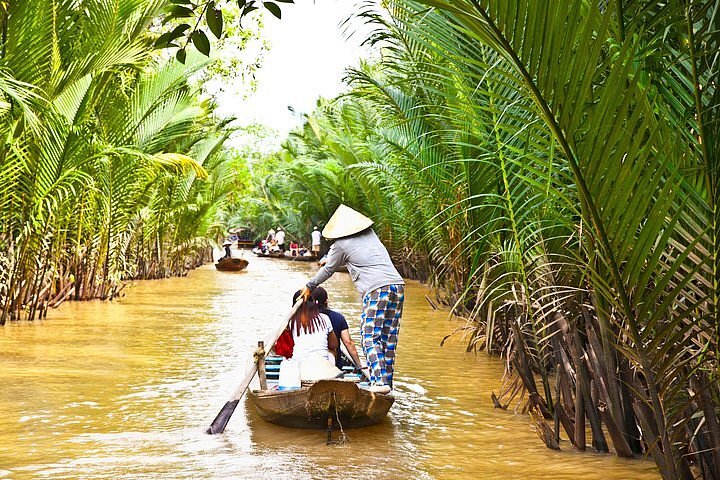
The Mekong Delta Tour invites you to embark on a serene and immersive journey through the iconic waterways, lush landscapes, and vibrant culture of Vietnam’s legendary Mekong Delta region.
- Introduction to the Mekong Delta:
- Begin your tour with an introduction to the Mekong Delta, often referred to as the “Rice Bowl” of Vietnam due to its fertile lands and abundant agricultural production. Learn about the delta’s vital role in Vietnam’s economy, culture, and ecosystem, as well as its significance as a major riverine region in Southeast Asia.
- Boat Cruise along the Mekong River:
- Embark on a scenic boat cruise along the Mekong River, winding through a network of waterways, canals, and floating markets. Experience the rhythm of life along the riverbanks, passing by lush greenery, traditional stilt houses, and bustling fishing villages.
- Floating Markets:
- Explore the lively floating markets of the Mekong Delta, where local vendors gather to trade a variety of goods, fruits, vegetables, and handicrafts. Witness the vibrant colors, sounds, and aromas of these bustling markets as boats navigate through the waterways, creating a unique and dynamic spectacle.
- Traditional Villages and Rural Life:
- Visit traditional villages nestled along the Mekong Delta, offering insights into rural life, traditional crafts, and cultural practices. Interact with local artisans, observe traditional handicrafts such as weaving, pottery, and coconut candy making, and learn about the sustainable farming methods employed by local communities.
- Island Retreats and Ecotourism:
- Discover tranquil island retreats and ecotourism destinations within the Mekong Delta, where you can immerse yourself in nature, wildlife, and sustainable tourism initiatives. Explore lush orchards, wildlife sanctuaries, and eco-friendly resorts that showcase the delta’s biodiversity and natural beauty.
- Culinary Delights:
- Indulge in the culinary delights of the Mekong Delta, known for its fresh seafood, tropical fruits, and regional specialties. Sample local dishes such as fish cooked in clay pots, grilled river prawns, coconut-infused desserts, and refreshing fruit juices made from exotic fruits like dragon fruit, pomelo, and mango.
- Cultural Performances and Traditions:
- Experience traditional music, dance, and cultural performances that highlight the heritage and traditions of the Mekong Delta. Witness folk music performances, dragon boat races, and ceremonies that celebrate the delta’s cultural diversity and community spirit.
The Mekong Delta Tour promises a captivating blend of natural beauty, cultural immersion, and culinary delights, offering a glimpse into the timeless rhythms of life along Vietnam’s legendary Mekong River and its delta region.
Cultural and Historical Significance of the Mekong Delta:
Delve into the rich cultural tapestry and historical significance of the Mekong Delta, a region steeped in tradition and heritage. Learn about the delta’s role as a cradle of civilization, with ancient settlements dating back thousands of years. Explore the diverse ethnic communities that call the delta home, each contributing to the region’s vibrant cultural mosaic. Discover traditional customs, festivals, and rituals that have been passed down through generations, showcasing the enduring spirit of the delta’s people.
Floating Markets and Traditional Villages:
Embark on a captivating journey through the floating markets and traditional villages that line the waterways of the Mekong Delta. Experience the lively atmosphere of bustling markets, where farmers and vendors trade a bounty of fresh produce, handicrafts, and culinary delights from their boats. Interact with locals as you visit traditional villages, where artisans practice age-old crafts such as weaving, pottery, and rice paper making. Immerse yourself in the daily rhythms of rural life, gaining insights into the delta’s agricultural heritage and economic vitality.
Historic Sites along the Mekong River:
Explore the historic sites and cultural landmarks that dot the banks of the Mekong River, offering glimpses into the region’s storied past. Visit ancient temples, pagodas, and shrines nestled amid lush landscapes, each with its own architectural style and religious significance. Discover remnants of colonial-era architecture and trading posts that reflect the delta’s role as a strategic trade route and melting pot of cultures. Learn about key historical events and figures associated with the Mekong River, from ancient kingdoms to modern-day developments.
As you embark on a Mekong Delta Tour, you’ll unravel the layers of history, culture, and natural beauty that define this enchanting region. From the vibrant floating markets and traditional villages to the historic sites along the Mekong River, each experience offers a deeper understanding of the Mekong Delta’s timeless allure and enduring legacy.
Ha Long Bay Cruise
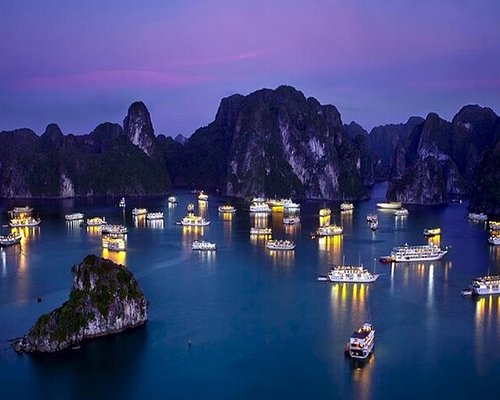
Embark on an unforgettable Ha Long Bay Cruise, where the emerald waters, towering limestone karsts, and enchanting landscapes create a magical setting for exploration and relaxation.
- Introduction to Ha Long Bay:
- Begin your journey with an introduction to Ha Long Bay, a UNESCO World Heritage site and one of Vietnam’s most iconic natural wonders. Learn about the geological formation of the bay, characterized by thousands of limestone islands and islets that rise dramatically from the sea, creating a breathtaking seascape.
- Cruise Experience:
- Board a traditional wooden junk boat or a luxury cruise vessel for an immersive experience on the tranquil waters of Ha Long Bay. Relax on the sundeck, sipping on refreshing drinks as you admire the panoramic views of limestone cliffs, hidden caves, and floating fishing villages.
- Limestone Caves and Grottoes:
- Explore the mesmerizing limestone caves and grottoes scattered throughout Ha Long Bay. Visit iconic sites like Sung Sot Cave (Surprise Cave) or Thien Cung Cave (Heavenly Palace Cave), adorned with stunning stalactites, stalagmites, and intricate rock formations that evoke a sense of wonder and awe.
- Kayaking and Water Activities:
- Engage in kayaking, swimming, or bamboo boat rides to get up close to the natural beauty of Ha Long Bay. Paddle through hidden coves, limestone arches, and emerald lagoons, discovering secluded beaches and pristine ecosystems teeming with marine life.
- Island Hopping and Beach Excursions:
- Hop from one island to another, exploring scenic spots and tranquil beaches along the way. Relax on white sandy shores, go snorkeling or diving to admire coral reefs and colorful fish, or simply soak in the sun while surrounded by stunning karst formations.
- Culinary Delights:
- Indulge in delectable Vietnamese cuisine and fresh seafood onboard your cruise, savoring flavorsome dishes prepared by talented chefs. Sample local specialties such as grilled squid, seafood spring rolls, and savory soups, accompanied by a selection of fine wines and beverages.
- Sunset and Nighttime Views:
- Witness the mesmerizing beauty of Ha Long Bay at sunset, as the golden hues paint the limestone cliffs in a magical light. After dark, enjoy stargazing on the deck or join evening activities and entertainment organized by the cruise, creating unforgettable memories under the starry sky.
A Ha Long Bay Cruise promises a journey of discovery, relaxation, and natural splendor, allowing you to immerse yourself in the timeless beauty and tranquility of this UNESCO-listed treasure in Vietnam.
Natural Beauty of Ha Long Bay:
Embark on a Ha Long Bay Cruise and immerse yourself in the unparalleled natural beauty of this UNESCO World Heritage site. Marvel at the breathtaking scenery characterized by thousands of limestone karsts and islets emerging from the emerald waters of the Gulf of Tonkin. Admire the serene bays, hidden lagoons, and towering cliffs draped in lush vegetation, creating a mesmerizing backdrop for your cruise experience.
Ancient Fishing Villages:
Explore the charm and heritage of ancient fishing villages dotted throughout Ha Long Bay. Witness the traditional way of life as local fishermen navigate colorful wooden boats, cast their nets, and tend to floating fish farms. Visit floating villages like Cua Van or Vung Vieng, where wooden houses perch on stilts above the water, offering glimpses into centuries-old maritime traditions and community spirit.
Limestone Caves and Prehistoric Remnants:
Delve into the mysterious world of limestone caves and prehistoric remnants hidden within Ha Long Bay’s karst formations. Discover enchanting caves such as Sung Sot Cave (Surprise Cave) or Hang Sung Sot, adorned with spectacular stalactites and stalagmites that form intricate patterns and chambers. Uncover traces of prehistoric life, ancient rock art, and geological formations that hint at the bay’s ancient history and natural evolution over millions of years.
As you cruise through Ha Long Bay, you’ll be captivated by the harmonious blend of natural wonders, cultural heritage, and geological marvels that define this iconic destination. From the stunning landscapes and ancient fishing villages to the hidden caves and prehistoric remnants, each aspect of the cruise offers a deeper appreciation for the timeless allure of Ha Long Bay.
Conclusion Historical Tours in Vietnam
Historical tours in Vietnam offer a captivating journey through time, showcasing the country’s rich heritage, cultural diversity, and tumultuous history. From the ancient temples of My Son Sanctuary to the wartime relics of Cu Chi Tunnels, each destination unveils layers of stories, traditions, and legacies that have shaped Vietnam’s identity. Exploring Hanoi’s historical sites provides insights into Vietnam’s political past and colonial influences. The imperial city of Hue offers a glimpse into the country’s royal heritage, while Hoi An’s UNESCO-listed old town preserves centuries-old architecture and trading history. Venturing into the Cu Chi Tunnels reveals the resilience of the Vietnamese during wartime, while tours of Phong Nha-Ke Bang National Park showcase the natural beauty and cultural significance of the region. The DMZ Tour and Ha Long Bay Cruise add historical and natural dimensions to Vietnam’s narrative. Historical tours in Vietnam not only educate and enlighten but also inspire a deep appreciation for the country’s diverse heritage and the enduring spirit of its people.
Read more Historical Tours in Cambodia


